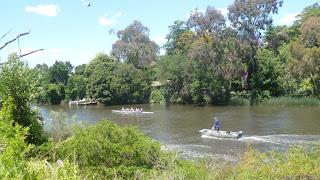On the eve of our departure for America I take computer in hand for one final entry. It is hard to contemplate, or even comprehend, what sort of country we will return to, but an objective analysis of this society has convinced me that it, too, may be suffering from a tremendous upsurge in xenophobia and racism. I have seen nothing personally to verify this, mind you, yet I have read quite a few editions of the Rupert Murdoch-owned newspapers here and seen the same disgusting rhetoric that has gained a foothold in my own benighted homeland over the last few months. Fortunately, my actual experiences yesterday completely contradicted that sense of a fascist zeitgeist, but I will have to back up to tell the tale.
We left Melbourne on the Monday morning train and endured the 11 hour ride back to Sydney. It is not as bad as it sounds, because on the train there is no one to constantly pester you about wearing a seat belt (there aren't any) and you are free to move about as much as you want. The passenger trains do not have lounge cars here, however, so your walking about and stretching is confined to trips made to the "buffet" car where a narrow passage is provided for passengers to order food and beverages. Small alcoves between the cars allow for some stretching room, and of course, there is always periodic swaying, clumsy trek to the toilets. The food is not bad on these trains, and true to her habit of photographing attractive meals, Jayne decided to snap this shot of her choice for lunch.
We arrived at Sydney just as it was getting dark and, ironically, we had to catch an urban line which backtracked the same route we had just traveled. We arrived at a station that Google Maps told us was no further than 750 meters from our next lodging, but of course it did not tell us that distance was almost straight up. Fortunately our host
came and collected us at the station in his car, and brought us to this lovely restored Victorian era mansion where I now type these lines. It must have cost a fortune to change this palace into six luxurious, self contained apartments, and the effort has truly paid off for guests such as ourselves. This apartment has everything, and is thoroughly modern and clean. What was even more incredible was the arrival next morning of our host with a continental breakfast try for our enjoyment. As always, my lovely partner recorded the attractive meal:Arncliffe, the suburb where this place is situated, is close to nothing and conveniently located to less than nothing, which may partially account for the host's royal treatment and the low price, but we chose it for an entirely different reason. Blanca Tovias, a scholar of Blackfeet Indian studies who I met years ago when she was doing research in our Special Collections reading room at the Montana State University Library, lives nearby with her husband Philip, and we wanted to spend our final days in Sydney visiting with them. Blanca has retired
from the faculty of the University of Sydney to pay attention to her grand children, and Phillip is a retired engineer. They are lovely people and devoted an entire day to showing us their world. Among the sites we took in were the beach at La Perouse and a monument that marked the place where a French exploring vessel arrived at Botany Bay in 1788 just a couple of days after the arrival of the British first fleet of convict ships. Not only did La Parouse miss his opportunity of claiming Australia for the French, he had the dubious further honor of having one of his crew members die during his visit (making him the first European to expire on this continent) and then became lost at sea after the crew departed for France. Tough luck.
But all this attention to the misty past and Gallic exploration is not the multi-cultural lesson I wanted to convey in this essay. You see, Dr. Tovias was actually born in Mexico, and only came to Australia after marrying her husband who she met while he working on a project in her home town. She is the only person I have heard who speaks Australian with a Mexican accent, which would be impossible to duplicate by the most talented mimic. Obviously you would expect an educated person of such ethnicity to be the sort to celebrate the expanding cultural society of Australia and you would be right. She and Phillip took us to their favorite coffee house, operated by some Lebanese and situated in a neighborhood that is home to a growing population of people from Nepal, who live along side of a substantial Chinese residential contingent. Blanca explained how much they love the vibrancy of the shops here, and among the stops we made after
coffee was a Lebanese bakery with the most delicious and beautiful arrangement of goods I have seen anywhere (and I have been to Paris)! The proprietor allowed Jayne to take her portrait behind the counter as she loaded us up with a variety of goodies that Blanca ordered. Phillip next ducked into a hookah store where he bought charcoal for his Christmas barbecue, and we took the lot back to the car to drive back to their home. In short, it was a lesson in how all societies with a little effort can learn to live with one another, and appreciate their differences, even celebrate them. Thank you, Australia, for restoring my hope.






















